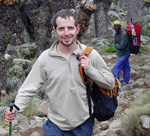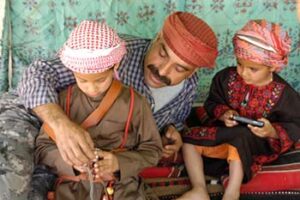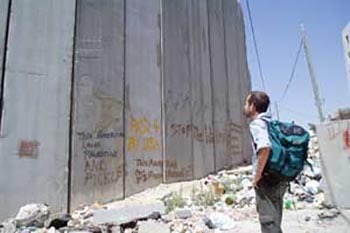A Brief Tour of the Holy Land – Page Five

By Roman Skaskiw
Someone relayed a message from them: all internationals and Israeli citizens must leave the area. Seconds later, everybody, including Palestinians, made a determined move back into town.
Having gone through this together, we were all suddenly great friends, eager to talk. I gained respect for the protesters too. They had braved the batons of the soldiers. I bought one lady an ice cream cone. People showed off the golf-ball sized welts around their rubber bullet wounds. One of the experienced protesters told me that if I want to understand the Middle East, I should travel to Hebron on a Saturday. I’m now sorry we decided against it.
The organizer in the cowboy hat eventually gathered everyone and solicited feedback about the protest. He wanted advice for next week’s.
Most of what I know about that week’s protest came from speaking with people afterwards, and finding a video clip on the web that one of the courageous anarchist-looking types had made with surprising access to the action.
I learned we were still a half-kilometer from our destination when the march was scattered. I learned one of the protesters will never be the same again. He was an Israeli Jew and a lawyer who did legal work on behalf of Palestinians. He was shot in the head with a rubber bullet and suffered a fractured skull. He has since had two brain surgeries.
I learned that during the following week’s march, protesters faced a water/ink cannon that stained people’s clothing and skin.
We took a bus back to Jerusalem. I thought about John F. Kennedy’s famous adage: “Those who make peaceful protest impossible, make violent revolution inevitable.”
I thought about how combat compared to what some called civil disobedience, though I’m not sure the term applied to us since it was, for time being, still legal to conduct peaceful protests. In combat you maneuver. In a protest, you accept vulnerability to walk down symbolic terrain.

In combat you do things as safely as possible. In a protest, you seek limited exposure. (Although it was clear to me that soldiers violently put down a peaceful protest, it seemed that some of the more experiences demonstrators sought minor injury so they’d have tangible evidence of injustice.) In combat it’s about killing. In a protest it’s about publicity and the right to express discontent.
They do have a few things in common: noise, adrenaline, confusion.
Pitcher of Carlsberg in West Jerusalem: 30 shekels.
“What do you think Chuck Norris would have done in that situation?”
August 12: To get to Bethlehem from Jerusalem, we passed through an airport-like security terminal, then walked downhill along the wall. I hadn’t realized the two cities were so close together.
My first impression: Bethlehem was a town of hustlers. We were set upon by a crowd of cabbies trying to give rides to tourists. They wanted thirty shekels, and only came down to ten shekels when we began walking away. Ten was still expensive for what turned out to be a very short trip. The driver pulled over well before we reached Manger Square. He flipped through postcards of local attractions.
“Castle David,” he said. “Very nice. Church Nativity. Very nice. I take you.”
“No thanks. Manger Square.”
“Why no? Very nice.”
“Manger Square please.”
“I take you now. Then back to wall.”
“Manger Square.”
“Castle David.”
“Manger Square.”
He signed with more affectation of suffering than I would have tolerated from, say, one of my soldiers, and pulled back onto the road.
When I handed him a ten-shekel coin at Manger Square he put on a distressed expression and said: “Not enough. Ten Each,” at which point I slammed the door in his face.
We studied the map, trying to orient ourselves toward a hostel. A man from a nearby souvenir shop approached us.
“Maybe you look for my store on the map,” he said, grabbing my arm. “Come.”
Once we learned to cold-shoulder the hustlers, things became much easier. We ate falafel and ogled the more liberally dressed Christian woman. “Praise Jesus,” Steffen said.
Several times, people sitting outside their homes stopped us to chat. One man said, “You have to tell Bush that we need help, they are choking us.” He sat on a stool and put his beer down to make a choking gesture with both his hands.
I expected a criticism of Israeli policies – it’d been a running theme – but then he said: “The Muslims want our homes and our women.” I told him I’d never heard that before and pressed him for specifics.

“We are between two lions, and we are a goat,” he said, then made another choking gesture with his hands. His beer was very large, and he looked like he’d been sitting there for a very long time.
In some of the alleys, I noticed martyr posters — images of young Arab men posing with weapons, superimposed over the Dome of the Rock.
I didn’t realize it when we arrived at Deheishe refugee camp. It seemed like just another part of Bethlehem. Only after walking through it, did I begin to notice the crowding, the crumbling homes built literally on top of one another, the rusted scrap metal used to mark off a tiny garden, or the remnant of fence we later learned was built by Israel during the First Intifada and had completely encircled the camp until 1995.
The camp’s Ibdaa Visitor Center offers free tours. Our guide introduced himself as Jihad. Twice, I asked him to repeat his name, thinking I’d misheard it. He was a cheerful part-time college student studying business, but doubted the degree would get him out of the camp.
He rattled off statistics: Refugees from forty-five villages founded the camp in the aftermath of the 1948 war. Then, the 3,400 refugees occupied one-and-a-half square kilometers. Now, their 11,000 descendents occupy the same one-and-a-half square kilometers. Since the election of Hammas and the subsequent financial restrains against their government, unemployment jumped from about 60% to almost 100%. The U.N. provides everything from food to sanitation.
He said it is difficult for him to travel, and that many of his friends have never seen the ocean. He explained that Christian refugees left the camp long ago, helped by various church-based charities, and that structures replaced tents after many refugees died of exposure in the winter of 1952-53.
I asked if that was when the West Bank was still a part of Jordan.
“Yes,” he said, “and to be honest, they were bad to us too.”
He explained that when the residents of the camp protested in Manger Square during the 1960’s, Jordanian soldiers used live ammunition, killing some protestors and scattering the rest, much worse, it seemed, than the protest I’d witnessed in Bil’in.
Falafel and bottle of water in Bethlehem: 4 shekels.
Purse embroidered by Deheishe residents under a U.N. sponsored self-help program: 80 shekels.
August 13:
BBC News: Leaders Agree to U.N. Truce Timing
CNN: Hostilities to End Monday Morning
Jerusalem Post: 24 Soldiers Killed as Fighting Rages in S. Lebanon
Al Jazeera: Text of UN 1701 Resolution
A grandfatherly man in a Yankee cap with an M-16A1, (Vietnam era) dangling from his shoulder greeted us at the gate of Kibbutz Kfar Etzion. Before we reached the gate, we passed a parking lot, and before that, a gas station and convenience store with Hebrew signs. This, I think, is noteworthy because the kibbutz is what some call a settlement. It lies in the West Bank and didn’t seem to have a tightly regarded boundary.
Our taxi drove over broad highways that connect the settlements to one another, and to Israel proper. We passed a line of vehicles with green (Palestinian) license plates stopped by a military patrol – what in Iraq we called a rolling checkpoint. The soldiers saw our taxi’s yellow (Israeli) license plate, and waved us passed. This took place inside the West Bank.
The kibbutz looked beautiful: imported trees, modern, vine-covered buildings, young people reclining on lush lawns. Young people everywhere it seemed – many pushing baby strollers. I recognized the familiar tones of American English.
When I spoke with people, their eyes shifted back and forth from my face to the hatless top of my head.
I asked one young lady about the orange ribbons people wore. She explained they were showing solidarity with those evacuated from Gaza in 2005. She was concerned about their future, and told me she prays every day that they will not be made to leave. I asked about the war. She had three brothers fighting in Lebanon. She was one of nine children.
The “Sound and Light Show,” and occasion for our trip to the Kibbutz, is a movie about the history of Kfar Etzion. It described the ambitious attempt to build a community in “the heart of the Judean Hills” despite unsuitable farmland, the absence of a reliable water source, and the close proximity of four “hostile Arab villages.”
The first settlement was built in the 1920’s. It was abandoned during the 1929 riots. The second, built in the 30’s, met a similar fate. The third attempt began in 1943. By 1947 the “Etzion Bloc” consisted of four settlements and 2,500 acres.
When the 1948 war erupted, residents decided to defend the settlement. The movie details the months-long siege. Eventually, the defenders were overcome and killed. Most of the settlement was razed, save for a lone oak tree visible from the Israeli-side of the pre-1967 border.
The movie screen then lifts to reveal the remnants of the bunker in which the defenders made their last stand. Viewers are invited to step down and look more closely. A second movie screen lights up and explains how for nineteen years, the residents who’d been evacuated from Etzion and their descendents periodically gathered at the border to gaze at the lone oak. The movie triumphantly explains that after the 1967 war, those descendents re-established the settlement block. Its population is now close to 30,000 and it continues to grow. No further mention was made of the four “hostile Arab villages” that had initially been an obstacle.
Through the frosted, armored windows of the bus returning to Jerusalem, I saw long lines of Israeli children walking along the roads near the Kibbutz, hundreds of them holding hands, book bags bouncing on their shoulders. I wondered about boundaries. I wondered if many of them, like the young woman I spoke with, had eight siblings. Men my own age guarded the kids. They wore baseball caps and carried M-16s.
Much of the landscape is terraced, with different levels separated by walls of crumbling rock. Occasionally I saw homes built along those walls. I hadn’t noticed them at first because they were small and built from the same grey stones. I saw a pair of Arabs reclining in the shade and watching my armored bus speed past on the Israeli-built highway.
August 14: The architecture of Yad Vashem, the Holocaust Museum, is somber and breathtaking. Most of the exhibits are in a long, triangular hallway. From the outside, it looks like the sharp ridge of a very straight mountain. The end of the corridor juts out over a valley, forming a large balcony.
The last exhibit is the Hall of Names, a enormous room lined with files containing the names of Holocaust Victims. Visitors then step onto the balcony, and see a panorama of the land of Israel, the place so many sought refuge.
The message seemed clear.
August 15: I’d been collecting Jerusalem Posts and other newspapers, and I read them on the bus ride to Tel Aviv.
I read about an Israeli soldier who refused to serve in Lebanon, not to protest the high rate of Lebanese civilian casualties (I’d read about those too), but to protest a statement by Prime Minister Olmert about withdrawing settlements from the West Bank. Shocking, but I admire how such polar-opposite beliefs co-exists within Israeli society, and in the editorial pages of their newspapers.
There was an ad by a major U.S. law firm seeking American citizens who’d been hurt by Hezbollah rockets for a class action law suit against Syria and Iran.
The pressure of history seemed lighter in Tel Aviv. We enjoyed beaches and nightlife. The manager of our hostel confirmed, as others had, that tourism was down because of the war, though parts of the beach were so crowded with sunbathers we had to walk in the surf.
Even in Tel Aviv, however the issue of borders is manifest. The map painted onto the wall of our hostel showed Israel and the surrounding countries, with no West Bank or Gaza strip. A British tourist gave the manager a hard time about this, offering to draw them in with a magic marker.
I couldn’t resist. Big Mac Meal at McDonalds: 32.40 shekels. (And it tasted just like a Big Mac.)
I said goodbye to Steffen and spent the last couple of days of my trip walking along the beach, all the way to the neighboring, Israeli-Arab city of Jaffa and back.
I hesitate to make pronouncements about the conflict. I’ll only say that I found it very easy to tour this part of the world. I did so with little money and without much planning. I’d encourage anyone interested in America’s policies in the area to do the same, to see it with their own eyes. Doing so, put the conflict on a human level for me, as opposed to a historic, or even biblical one. This gives me the courage to speak about it, and to write.

Roman Skaskiw served as an infantry officer with the 82nd Airborne Division in Afghanistan and Iraq. He was recently recalled for another tour in Afghanistan with the Kunar Province Provincial Reconstruction Team.
He is a 2007 graduate of the Iowa Writers’ Workshop. His work has appeared in The Atlantic, the New York Times, Stanford Magazine, Front Porch Journal, In The Fray Magazine, and elsewhere on GoNomad.com. He is shown here climbing Mt. Kilimanjaro.
Read more GoNOMAD stories by Roman Skaskiw:
Bukovel Resort: Skiing the Carpathian Mountains in Ukraine
A Visit to Bodrum, Turkey: Barracudas and Belly Dancers
Visiting Free Ukraine: A Journey Through the Shadows of History
Winneshiek County, Iowa: Canoeing the Upper Iowa River
Kilimanjaro: Climbing Africa’s Tallest Mountain
Touring Scenic Afghanistan: Climbing in Kunar
Read Roman Skazkiw’s essays in the Atlantic Monthly: Email from Afghanistan
and the New York Times: Home Fires: Life Lessons
- Camino Tales: Wine and Memories in Galicia, Spain - July 25, 2024
- Beluga Hunting in Norway - July 20, 2024
- Costa Rica: A Rainforest Chocolate Tour - July 18, 2024





